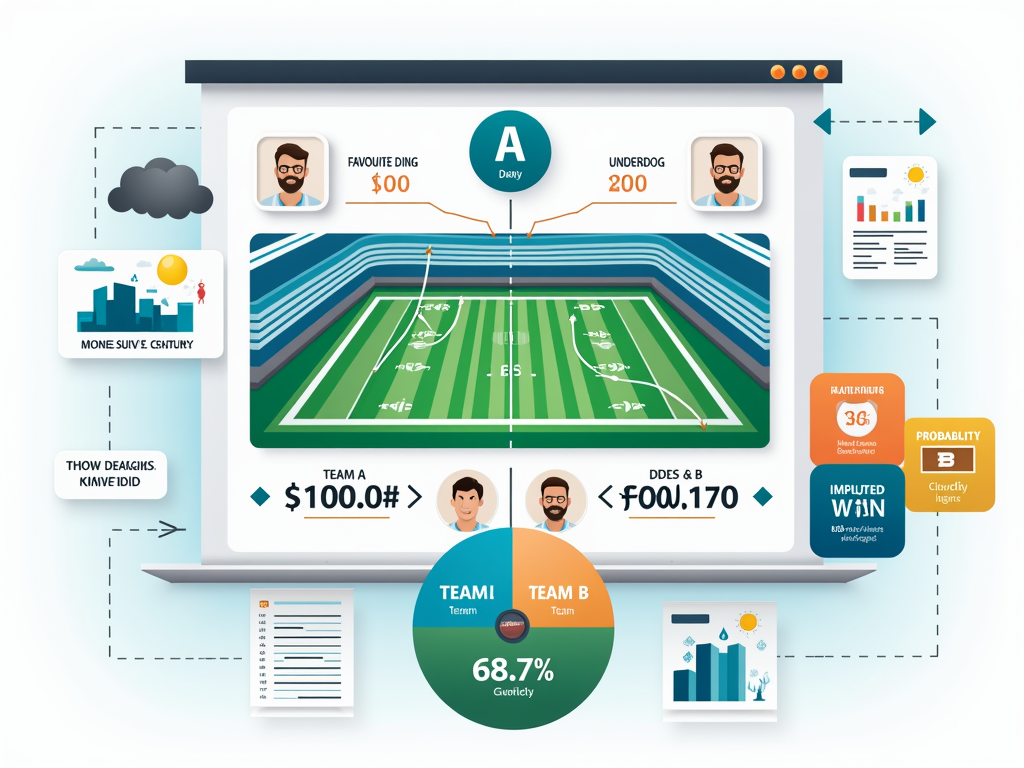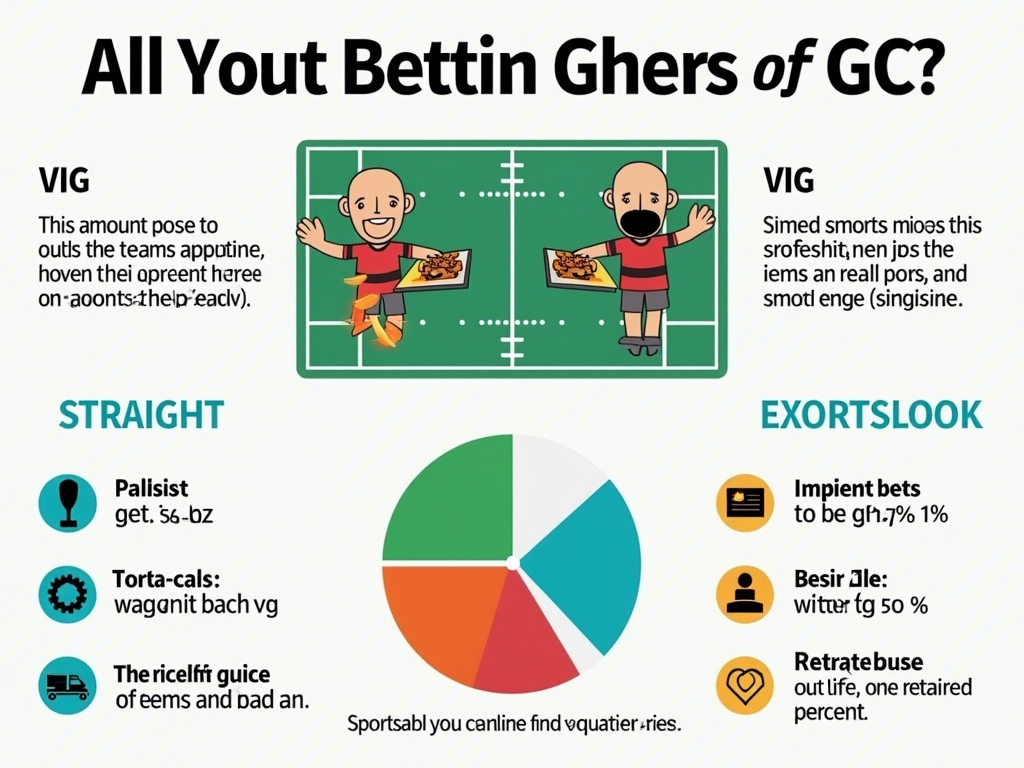Understanding the Three Main Types of Sports Bets
Sports betting centers on three main bet types that offer different approaches to finding value. Moneyline bets let me pick outright winners, point spreads create balance between teams, and totals focus on combined scoring. By learning how each type works, I make smarter betting choices through careful odds analysis.
Key Takeaways
- Moneyline betting provides straight winner picks, using minus signs (-) for favorites and plus signs (+) for underdogs and potential wins
- Point spreads add or subtract points from final scores to level matchups, with standard -110 pricing
- Totals (Over/Under) betting predicts combined scoring instead of picking winners
- The “vig” or house edge means betting $110 to collect $100 on typical bets
- Making profitable bets depends on analyzing injuries, matchups, weather conditions, and recent team performance
How Bet Types Reflect Game Analysis
I focus on clear factors that impact each bet type. Moneylines reflect true team strength, spreads consider margin of victory, and totals examine offensive and defensive capabilities. By breaking down these core elements, I spot opportunities across different betting markets.
Choosing Bets Based on Goals
The straightforward nature of moneylines makes them perfect for beginners. Point spreads help create value with evenly-matched teams. Totals offer an alternative by removing winner selection entirely. Each type serves specific betting goals while requiring unique analysis approaches.
Building Long-Term Success
Small edges add up over time through disciplined bankroll management and selective betting. I target games where my analysis shows clear advantages, regardless of bet type. This focused strategy leads to long-term success in sports betting.
Understanding Sports Betting Basics: A Guide to Moneyline Wagers
Moneyline betting stands as the most straightforward way to start placing sports wagers. I’ll break down exactly how these bets work and show you the smart way to read the odds.
How Moneyline Odds Work
In moneyline betting, I’m simply picking who I think will win the game—no point spreads or complicated rules to consider. The odds are displayed using either a negative (-) or positive (+) number. Negative numbers indicate the favorite, showing how much I need to bet to win $100. Positive numbers represent the underdog, displaying how much I’ll win on a $100 bet.
Let’s look at a clear example: Team A (-200) vs Team B (+170)
- To win $100 betting on Team A, I’d need to wager $200
- A $100 bet on Team B would return $170 in profit
- The bigger the negative number, the stronger the favorite
- Higher positive numbers mean bigger underdogs with larger potential payouts
Understanding Probability and Value
The odds tell me more than just potential payouts—they reveal the implied probability of each outcome. Taking those -200 odds on Team A, I can calculate that bookmakers give them a 66.7% chance of winning. This helps me decide if I’m getting good value for my money.
Several key factors shape these odds:
- Player injuries and availability
- Recent team performance and momentum
- Historical matchup results
- Home-field advantage
- Weather conditions (for outdoor sports)
- Team rest and travel schedules
I always check these elements before placing a moneyline bet, as they directly impact my chances of winning. The key is finding spots where I believe the true probability of victory is higher than what the odds suggest—that’s where the real value lies in moneyline betting.
Remember, just because a team is favored doesn’t automatically make them the smart bet. The odds need to offer proper value compared to my assessment of the actual win probability.

Making Sense of Point Spreads: The Great Equalizer
Point spreads create balance in sports betting by adding or subtracting points from a team’s final score. I’ve found that this betting type gives you a shot at winning even when backing an underdog, since they don’t need to win outright for your bet to pay off.
How Point Spreads Work
When you see a spread like Chiefs -7.5 vs Broncos +7.5, it means the Chiefs must win by 8 or more points for their backers to win. Broncos bettors cash in if their team either wins outright or loses by 7 or fewer points. The most common odds for spread bets are -110 on both sides, meaning you’d need to bet $110 to win $100.
Here are the key aspects of spread betting you should know:
- The favorite (marked with a minus sign) must win by more than the spread number
- The underdog (marked with a plus sign) can lose by less than the spread and still win the bet
- A .5 point in the spread (like -7.5) prevents ties, known as pushes
- NFL spreads often center around 3 and 7 points due to field goals and touchdowns
I recommend paying special attention to these “key numbers” in NFL betting, as they account for the most common margins of victory. For example, about 15% of NFL games end with a 3-point difference, making it a crucial number in spread betting strategies.
Sportsbooks often use half-points in spreads to prevent pushes – where the favorite wins by exactly the spread amount. With a 7.5-point spread, there’s always a clear winner since no team can score half a point.
Mastering Over/Under Totals: Beyond Winners and Losers
Over/Under (O/U) betting, also called totals betting, adds an exciting dimension to sports wagering by focusing on the combined final score rather than picking winners. I’ve found that understanding totals opens up fresh opportunities for smart sports betting strategies that don’t depend on choosing the winning team.
Breaking Down Totals Betting
Let’s say there’s an NBA game between the Lakers and Celtics with an O/U of 225.5 points. If you bet the over, you’ll win if the teams combine to score 226 points or more. Pick the under, and you’ll cash in if they score 225 points or fewer. The standard odds are typically -110 on both sides, meaning you’d need to bet $110 to win $100.
The betting options don’t stop at full-game totals. You can bet on:
- Individual quarter totals
- First-half or second-half scoring
- Team-specific totals
- Player prop totals
To make smart totals bets, I focus on these key stats:
- Points Per Game (PPG) for each team
- Opponent Points Per Game (OPPG)
- Pace Factor (possessions per game)
- Recent scoring trends
- Head-to-head scoring history
External factors play a huge role in totals betting. In outdoor sports, weather can dramatically impact scoring – think wind affecting passing in football or humidity changing how baseball travels. For indoor sports, factors like back-to-back games or key player injuries can shift scoring expectations.
Teams’ playing styles also heavily influence totals. A fast-paced team that likes to push the ball versus a slow, defensive-minded opponent creates an interesting clash that affects the total. I always check if teams prefer to play uptempo or grind out possessions before making my picks.
The beauty of totals betting lies in its simplicity – you’re simply deciding if the combined score will go over or under a number. But don’t let that fool you – successful totals betting requires careful analysis of statistics, trends, and conditions that affect scoring. By considering all these elements, you’ll be better equipped to spot value in the totals markets.

The House Edge: Understanding Vig and Payouts
Breaking Down the Vig
Let’s talk about the commission that sportsbooks take on bets – it’s called the vig (or juice). Think of it as a service fee for handling your wagers. When you see standard -110 odds, you’ll need to put up $110 for a chance to win $100. I’ve found this consistent pricing across most sports betting platforms and major markets.
Here’s a clear example of how the vig works in practice. When two bettors place opposing $110 bets on a game, the sportsbook collects $220 total. After paying out $210 to the winner, they keep $10 as profit. This built-in edge helps them stay profitable over time.
Impact on Betting Strategy
The vig creates an interesting effect on betting probabilities. You’ll notice that if you add up the implied probabilities of all possible outcomes in a bet, they’ll typically exceed 100%. This isn’t a mistake – it’s by design to create that house advantage.
Consider these key points about the vig’s impact on different bet types:
- Simple straight bets usually carry the standard -110 vig
- Parlay bets often include a higher commission percentage
- Exotic bets and props typically feature an increased vig
- Shopping for the best lines can help reduce the vig’s impact
- Some sportsbooks offer reduced juice promotions on select games
I’ve learned that understanding the vig is critical for long-term betting success. While you can’t eliminate it entirely, you can make smarter decisions by factoring it into your betting strategy. This means being selective with parlay bets, which carry a higher house edge, and focusing on straight bets where the vig has less impact on your potential returns.

Value Hunting: Finding the Best Betting Opportunities
Calculating True Value in Odds
Finding real betting value starts with comparing implied probabilities to my personal estimated win probability. When I spot differences between these two numbers, that’s where potential value exists. For example, if I calculate a team has a 60% chance to win, but the odds suggest only a 50% probability, I’ve found positive expected value. This approach forms the foundation of smart sports betting strategy and bankroll management.
Underdog bets can provide excellent value opportunities because they offer higher payouts when successful. I’ve learned to look beyond the favorite’s appeal and consider the complete picture. By tracking line movements, I can spot where the money’s flowing and identify potential value before it disappears. Key number thresholds in sports like football (3, 7, 10) often present prime opportunities for value hunting.
Maximizing Your Edge Through Research
To gain a competitive advantage, I compare odds across multiple sportsbooks. This practice, known as line shopping, can significantly boost long-term profitability. Even small differences in odds can have a substantial impact over time.
Here are the critical factors I consider when hunting for value:
- Home/away performance splits and historical matchup data
- Current injury status and projected lineup changes
- Weather conditions, especially for outdoor sports
- Recent team performance trends and statistical matchups
- Public betting percentages and sharp money movement
- Schedule spots (back-to-backs, travel situations, rest advantages)
I pay special attention to situational spots where casual bettors might overlook important details. A team’s performance metrics in specific conditions – like on short rest or after a long road trip – can reveal hidden value that odds don’t reflect.
Price sensitivity becomes crucial when I’m looking at favorites. A -150 favorite might offer value, but that same team at -180 could be overpriced. I maintain detailed records of my predictions versus actual outcomes to refine my probability estimates and improve my value identification skills over time.
Line movement analysis helps me understand market dynamics. When odds shift significantly, I investigate the cause – whether it’s injury news, weather updates, or sharp betting action. These movements often create opportunities where value emerges on the opposite side of the public’s betting preference.

Sources:
Action Network, What is a Moneyline
ESPN Chalk, Explaining Point Spreads
VSiN, Understanding Totals (Over/Under)
Bleacher Report, Beginner’s Guide to Sports Betting Terms





